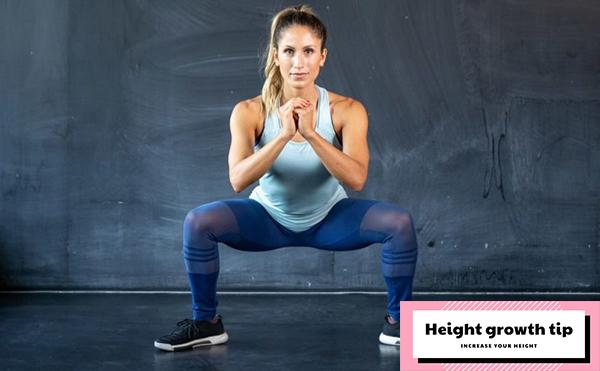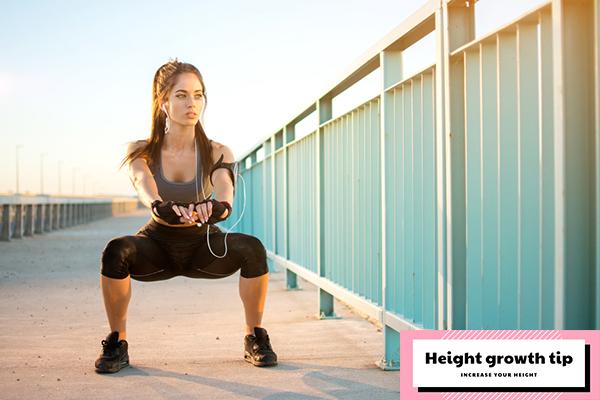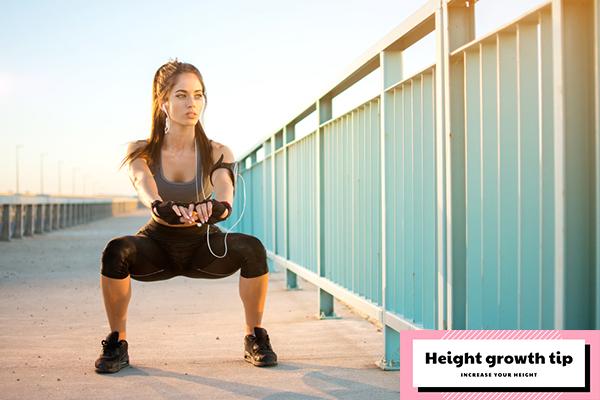Embarking on a journey to demystify this age-old conjecture, we venture forth in search of clarity. As seekers of truth, we’re compelled to discern fact from fiction, shedding light on the elusive relationship between squats and stature. Join us as we delve deeper into this captivating conundrum, unraveling the tangled threads of speculation that shroud the impact of squats on one’s height. Let us navigate the murky waters of fitness lore and uncover the veritable truths that lie beneath the surface.
Do squats impede height growth?
Among individuals, particularly adolescents, a lingering concern revolves around whether squats could adversely affect their height. The prevailing belief that squats might lead to a reduction in height or impede growth is a widespread misconception. However, let us delve further into the realm of facts.
While executing a squat, there is indeed an occurrence known as “spinal compression” resulting from the substantial load imposed on the spine. This compression may result in a temporary decrease in height, typically measuring around 3-4 millimeters. Nevertheless, it is crucial to emphasize that this height diminishment is fleeting, and the spine will naturally decompress, returning to its original length within an hour after the completion of a squat routine.
For adults, there is no substantiated evidence supporting the assertion that squats can lead to long-term height reduction. Yet, what about teenagers? Could squatting potentially hinder their growth?
The concern regarding adolescents centers around their growth plates, which are active areas situated near the extremities of their bones. These growth plates play an integral role in bone development, and any harm inflicted upon them theoretically carries the risk of stunted growth or deformities. Experts widely concur that growth plates typically fuse around the age of 16 in girls and between the ages of 14 and 19 in boys. For individuals within these age brackets, it is reassuring to know that squats are unlikely to impede growth.
It is vital to note that there have been no documented instances of growth plate injuries in children when weightlifting is conducted correctly and under the supervision of knowledgeable individuals. However, it is not without its risks, particularly when executed with poor form or excessively heavy weights.

What is the best type of squat for height?
Squatting in the correct form and position can indeed contribute to improved posture by strengthening the back muscles that support the spine. Additionally, squats can stimulate the production of testosterone and growth hormones, which are important for vertical growth. Here are some of the best types of squats you can try to potentially increase your height:
-
Basic Squat:
- Begin in a normal standing position.
- Lower your hips until your thighs are parallel to the floor.
- Raise your hands in front of you.
- Keep your knees aligned and feel the squat in your thighs and buttocks.
- Exhale and return to the starting position.
-
Squat Jump:
- Start in a standing position.
- Lower yourself into a squat position with your feet hip-width apart.
- Propel yourself forcefully upward by pushing off your heels, spreading your legs.
- Land in a squat position and repeat.
-
Side Squat:
- Stand straight with your feet shoulder-width apart.
- Take a wide step to the right with your right foot and bend your knee.
- While straightening your legs, step your right foot back.
- Repeat the same on the left side.
-
Sumo Squat:
- Place your feet wider than hip-width apart.
- Lower yourself into a squat position with your knees following the direction of your toes.
- Raise your arms overhead while maintaining an upright posture.
- Return to a standing position and repeat.
-
Goblet Squat:
- Stand with your feet wider than shoulder-width apart, toes slightly turned out.
- Hold a dumbbell in front of your chest.
- Shift your weight onto your heels, bend your knees, and lower your hips back and down as if sitting in a chair.
- Engage your core and keep your shoulders from rounding.
- Pause when your thighs are parallel to the floor, then push through your heels to return to the starting position.
-
Front Squat:
- Hold one or two dumbbells securely in front of your shoulders.
- Stand with your feet wider than shoulder-width apart, toes slightly turned out.
- Shift your weight onto your heels, bend your knees, and lower your hips toward the floor.
- Engage your core and maintain an upright posture as you lower.
- Pause when your thighs are parallel to the floor, then push back to the starting position and repeat.
It’s important to note that while these exercises may help strengthen and tone various muscle groups, their direct impact on height increase may vary among individuals. Height is primarily determined by genetic factors and growth plates, which fuse at a certain age. Consulting with a healthcare professional or a fitness trainer can provide personalized guidance and recommendations based on your specific goals and circumstances.
Exploring the Path to Height Enhancement Through Squats
When embarking on the quest to unlock one’s hidden height potential through squats, it becomes evident that a holistic and multifaceted approach is paramount. Delve into the depths of this transformative journey by considering the following pivotal elements:
- Mastering the Art of Squatting: Before delving into the world of height-boosting squats, it is of utmost importance to become a true virtuoso in the realm of proper squatting technique. To achieve this, seek guidance from certified professionals or delve into reputable online resources that can serve as your compass on this transformative journey. Precision in execution is the cornerstone upon which your progress will be built.
- The Art of Patience and Perfect Form: Patience, as they say, is a virtue, and it becomes your steadfast ally in this endeavor. Resist the temptation to push your limits aggressively right from the start. Instead, embrace a gradual progression that places an unwavering emphasis on maintaining impeccable form throughout every squat. This measured approach not only enhances your chances of success but also significantly reduces the risk of injury along the way.
- Frequency and Duration: As you embark on this transformative journey, commence with a regimen of squatting 3 to 4 times a week, dedicating at least 5 minutes to each session. However, be vigilant as you advance, gradually increasing the frequency to 5 or 6 times a week, always ensuring that your form remains impeccable. The key is to strike the right balance between intensity and consistency.
- The Crucial Role of Rest Intervals: Adequate rest between sets is an indispensable element of this journey. It allows your spinal discs to relax and recover, preventing any potential height loss due to overburdening. Tune in to your body’s cues and embrace rest whenever it is needed, for it is an essential part of the process.
- Embrace a Holistic Lifestyle: Beyond the confines of squats, broaden your horizons by engaging in a diverse range of physical activities, such as yoga, cycling, walking, or swimming. These endeavors not only contribute to improved posture but also cultivate an overall taller appearance. Remember to maintain proper hydration by consuming ample water throughout the day, as this aids in retaining fluids within the spinal discs. Additionally, fuel your body with a balanced diet rich in protein and calcium to maximize the effects of your efforts.
It is essential to recognize that while squats and lifestyle adjustments can indeed impact your posture and overall appearance, the potential for height increase through exercise is inherently constrained by genetic factors and the closure of growth plates. For personalized guidance tailored to your unique circumstances and aspirations, it is advisable to consult a healthcare professional or a fitness expert. Their insights can provide you with a roadmap aligned with your individual needs.
Unlocking your latent height potential is an extraordinary journey that necessitates discipline, unwavering technique, and an all-encompassing approach to your lifestyle. By seamlessly integrating these elements into your life, you can confidently aspire to stand tall and reach new heights.

Unveiling the Profound Health Benefits of Squats
Beneath the alluring promise of increased height lies a goldmine of extraordinary health advantages waiting to be unearthed through the art of squatting:
- Calorie Incineration Marvel: Squats reign supreme as the ultimate calorie-burning exercise. They stand as the clandestine weapon in the relentless battle against weight gain, chiseling a leaner, more sculpted physique. The engagement of major muscle groups during squats demands a substantial energy expenditure, setting your metabolism ablaze like a roaring furnace. Remarkably, this calorie-burning spectacle doesn’t cease with the conclusion of your workout; it persists through the recovery and cooldown phases, leaving your body sizzling with expended energy.
- Mastery of Balance and Mobility: Squatting isn’t just about leg strength; it’s a comprehensive discipline that nurtures both leg strength and core stability—an indispensable duo that becomes increasingly vital as time marches on. Strengthening these foundational elements enhances your sense of equilibrium and coordination, acting as an impenetrable shield against the looming threat of falls. Moreover, the act of squatting fosters a complex interplay between muscle groups and the brain, leading to heightened mobility and graceful movement.
- Heightened Flexibility: Regular encounters with squat exercises elegantly stretch and fortify leg muscles, ligaments, and tendons, ushering in a new realm of flexibility. Integrating squats into your routine can expand your body’s range of motion, preserving lower-body suppleness with an almost artistic finesse.
- The Citadel of Injury Prevention: Squats emerge as the bastion of defense, not only fortifying muscles but also the very sinews and scaffolding of your lower body. This newfound robustness and stability serve as an unyielding fortress, significantly reducing the likelihood of injuries, particularly those lurking in the shadows of the lower body.
- The Versatile Swiss Army Knife of Exercise: Squats are not confined to a one-size-fits-all mold. They offer a vast array of variations and adaptations, each uniquely challenging the body and targeting specific muscle groups. By incorporating diverse squat incarnations into your regimen, you ensure that your muscles remain engaged, evading the monotony of routine. Furthermore, squats require no fancy equipment and can be performed virtually anywhere, provided you have adequate space to gracefully lower your hips into position.
Incorporating squats into your fitness routine opens a treasure trove of health benefits. However, remember the cardinal rule: maintain impeccable form and gradually intensify your workouts to fend off the specter of injury. Seeking guidance from a fitness professional can further refine your squatting routine to harmonize seamlessly with your individual needs and aspirations.
In Conclusion
The myth that squats can lead to a decrease in height is baseless. While it’s true that squats may temporarily compress the spine by a few millimeters for a brief period, it’s crucial to understand that the intervertebral discs quickly return to their original state. In reality, squats offer a plethora of benefits suitable for individuals of all age groups. Nevertheless, it’s imperative to approach them with mindfulness and perfect technique.
Whether you are a concerned parent observing your child’s interest in squatting or an adult contemplating the incorporation of squats into your fitness regimen, seeking advice from a healthcare professional is highly recommended. They can provide invaluable support and personalized guidance to ensure that you engage in squats safely and effectively, taking into consideration your unique circumstances.
- Related post: Does Swimming Make You Taller?

